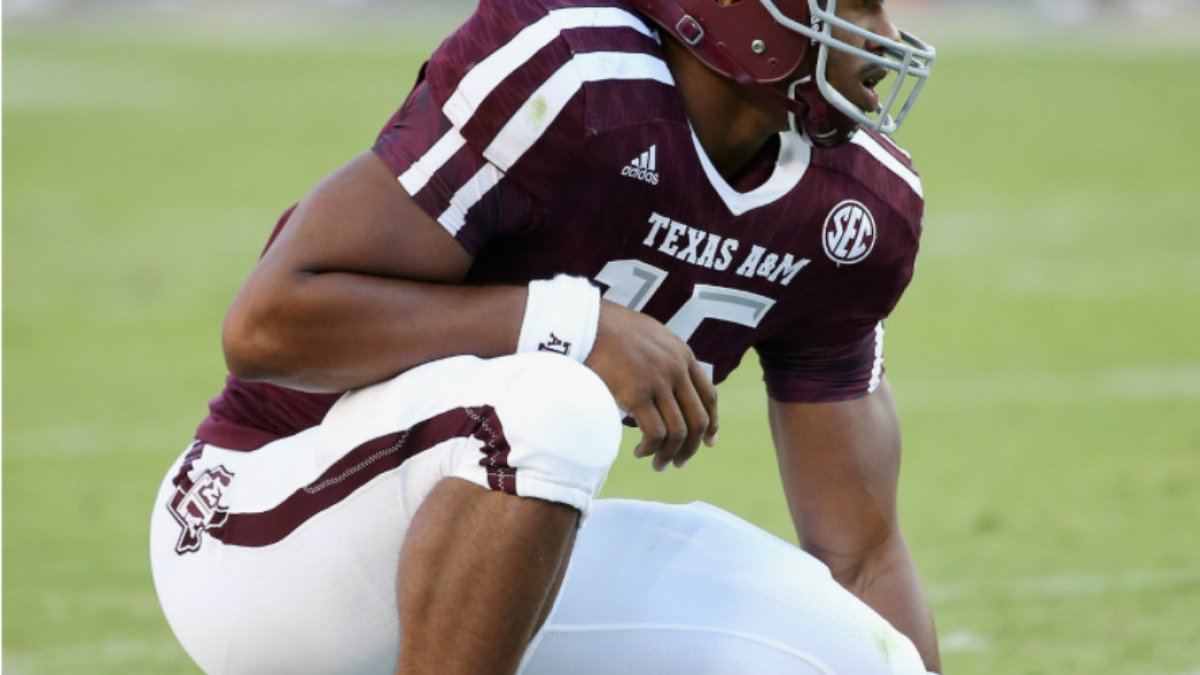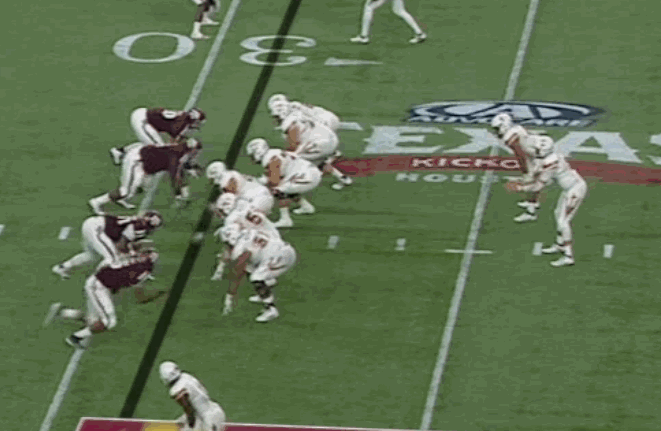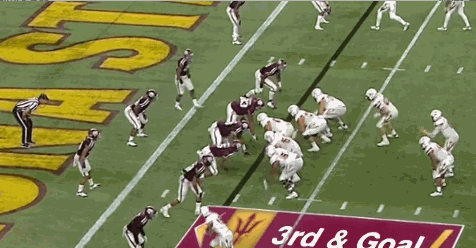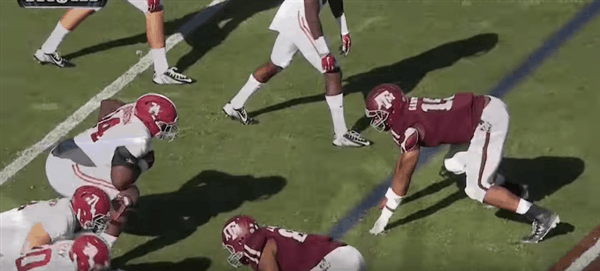While the Heisman Trophy is Louisville QB Lamar Jackson’s to lose through one month of the season, we can still search for the top runners up in case things fall apart at the top.
Enter Texas A&M defensive end Myles Garrett. The nation’s best pass-rusher has improved his work in the run game, and Texas A&M’s defensive improvement is one of the big stories of the young season. Garrett and the Aggies are undefeated as we head into October behind a defense that has allowed only 16.0 points per game.
The Heisman has almost unanimously been awarded to offensive players as they’re easier to evaluate and in the spotlight far more often than their defensive brethren. Defensive players have rarely been a part of the Heisman conversation because they’re either not viewed to be as valuable or their impact is simply more difficult to quantify. Yards and touchdowns are easy to see but shedding blocks and pressuring the quarterback have never been quantified properly to give defensive players a fair shake. There’s also the constant need to find a “Heisman moment,” which flies in the face of focusing on a player’s consistency over 500-900 snaps, and finding that moment for a defensive player can be tricky without handling the ball 30-40 times a game like their offensive counterparts.
In order for a defensive player to be considered for the Heisman Trophy, there are a few things that need to happen, whether they’re within the player’s control or not.
First, counting stats are a must. Sacks, interceptions, forced fumbles, fumble recoveries are all great numbers to throw out to Heisman voters. These numbers certainly do not define a player, but they are needed in order to make a splash. This is part of the big-picture issue as falling on an errant football or catching a tipped pass for an interception do not a season make, but they prevalence of these counting stats make it much easier to state a Heisman case. The other part of the Heisman voting that has become a much bigger part of the process than it should, is overall team record. The award has slowly moved toward an MVP award where a team’s record is nearly as important as a player’s actual on-field performances.
With that said, is Myles Garrett a Heisman candidate? Is there a scenario in which Garrett can at least get the invite to New York?
Of course there is.
The nation’s best pass-rusher
Two years of outstanding play put Garrett at No. 2 in the PFF College 101 heading into the season and he hasn’t disappointed through four games. He boasts the nation’s top pass-rushing grade at 89.8, this after posting a 92.8 mark in 2014 and 89.7 in 2015. Even with the added attention from opposing offenses, he’s pressured the quarterback at a higher rate than his career average (pressured quarterback on 18.3 percent of rushes compared to 17.3 percent for his career).
His down-to-down impact has been as great as any pass-rusher in the nation the last three years, but that brings us to one of the obstacles with getting a pass-rusher to New York: sack totals. Despite our calling Garrett the best pass-rusher in the nation, he “only” has three sacks, and that’s hard to compete with the Lamar Jackson’s of the world who averages three touchdowns per half. Using sacks as a gauge of the entire season does not do justice to the true value of a pass-rusher, particularly when the process of achieving the sack is far more important than just obtaining the statistic. Pressuring the quarterback in two seconds to force him into a teammate’s sack or forcing a quick incompletion are more difficult to achieve than being on the opposite end and picking up the clean-up sack, and that’s where we can better quantify Garrett’s value.
Last season, quarterbacks in college football saw their passer rating (NFL version) drop from 95.0 in a clean pocket to 59.4 while under pressure. That’s the equivalent to taking an All-American candidate and relegating him to third-string. Garrett creates pressure as well as any every-down edge rusher in the country, particularly when factoring the speed in which he gets to the quarterback. This season, opposing quarterbacks have only completed 36.4 percent of their passes on plays in which Garrett has created pressure – that’s impacting the game without putting a sack on the stat sheet.
As good as Texas A&M’s defense has been at creating pressure from all angles, Garrett is still the nation’s most dominant force when given one-on-one matchups. Take his Week 1 battle against UCLA LT Conor McDermott, a potential NFL prospect in his own right. Garrett won a ridiculous 12 of their 24 head-to-head battles officially finishing with a sack, three QB hits, and six hurries on those plays including two other wins that didn’t go down as pressure because the ball was out so quickly from QB Josh Rosen.
It’s that ability to take over a game that makes Garrett special and a Heisman contender on his pass rushing alone.
Improved against the run
Garrett’s detractors will cite his work against the run as his major weakness, and while we don’t disagree it’s an area to improve, it actually has improved every year since he came in as a true freshman in 2014. Credit defensive coordinator John Chavis who has always coached excellent run-stopping defensive ends at LSU from Barkevious Mingo to Danielle Hunter, and when Chavis came over last season, we knew it’d lead to much-improved play from Garrett.
While Garrett doesn’t have many tackles this season, he’s continued to do a better job of reading and taking on blocks. From the standpoint of the Heisman voters, Garrett’s work against the run is irrelevant because there may only be a handful watching him closely enough to make a true assessment. At PFF, we factor in all aspects of the game, and while we acknowledge that Garrett’s pass rushing is by far the most important part of his Heisman campaign, playing at least adequate run defense is a prerequisite for starting the hype train. To this point, the run-game improvement has been noticeable and Garrett has turned into a playmaker in that part of his game as well.
Finding that Heisman moment
So where does a defensive end find that Heisman moment? As mentioned, the offensive Heisman candidates have numerous chances to woo the nation every week, but defensive players need to be at the right place at the right time. Look no further than the three previous defensive Heisman finalists: Notre Dame’s Manti Te’o in 2012, Nebraska’s Ndamukong Suh in 2009, and Michigan’s Charles Woodson in 1997. Of course Woodson won the award, in part due to his work on offense and special teams, but a leaping one-handed interception against Michigan State is one play that stands out in his incredible season. Te’o was on the receiving end of seven interceptions in his season while leading one of the best defenses to an undefeated regular season and a berth in the BCS championship game. Suh is best known for a 4.5 sack performance in the Big 12 championship against Texas, tossing QB Colt McCoy around the entire game while nearly leading Nebraska to the upset victory.
What could Garrett have in store for his Heisman moment? How about a key sack against No. 1 Alabama when they meet on October 22nd — perhaps against what many believe to be the nation’s best left tackle in Cam Robinson (even though he’s not the nation’s best left tackle). That’s a play that would surely stick in voters’ minds.
Perhaps a key goal line stop, as he had against Arkansas last weekend, could be just the moment Garrett needs to earn his flight to New York. Or perhaps it’s simply continuing his dominant play up front for the Aggies, and being the leader of the defense that suddenly has Texas A&M in the thick of the SEC West race and headed for a showdowns with East favorite Tennessee and Alabama during the month of October.
Both games will be great showcases for Garrett, and if he can continue to impact the game as a pass-rusher and in the run game, he deserves to be right near the top of any Heisman ballot.








 © 2025 PFF - all rights reserved.
© 2025 PFF - all rights reserved.